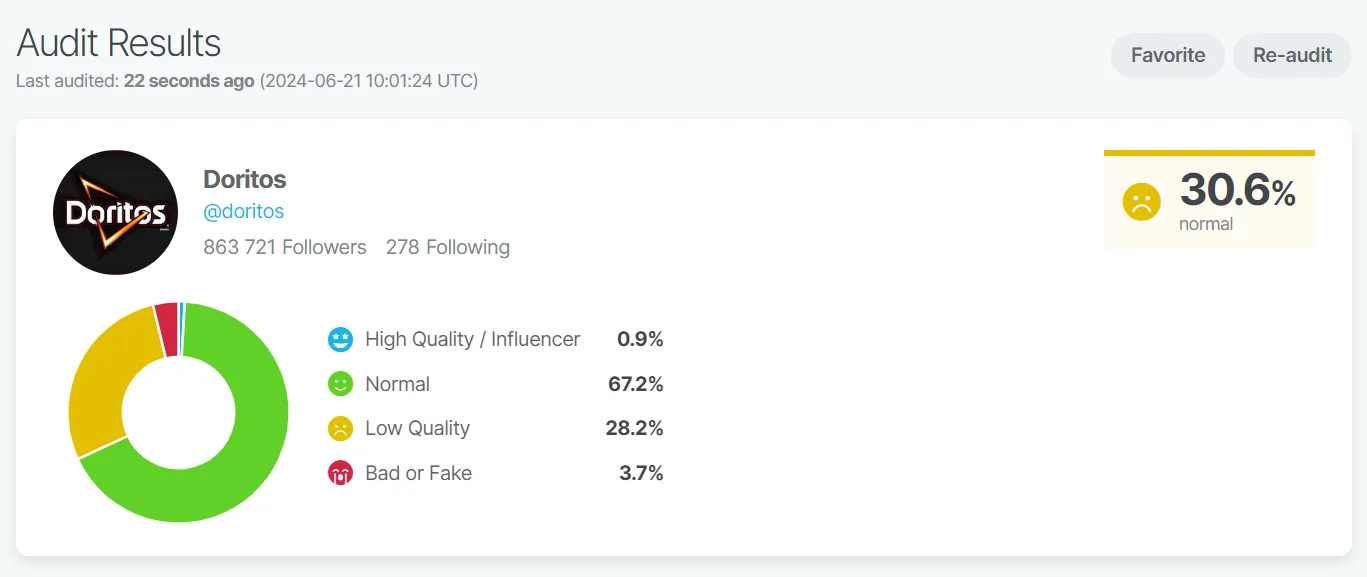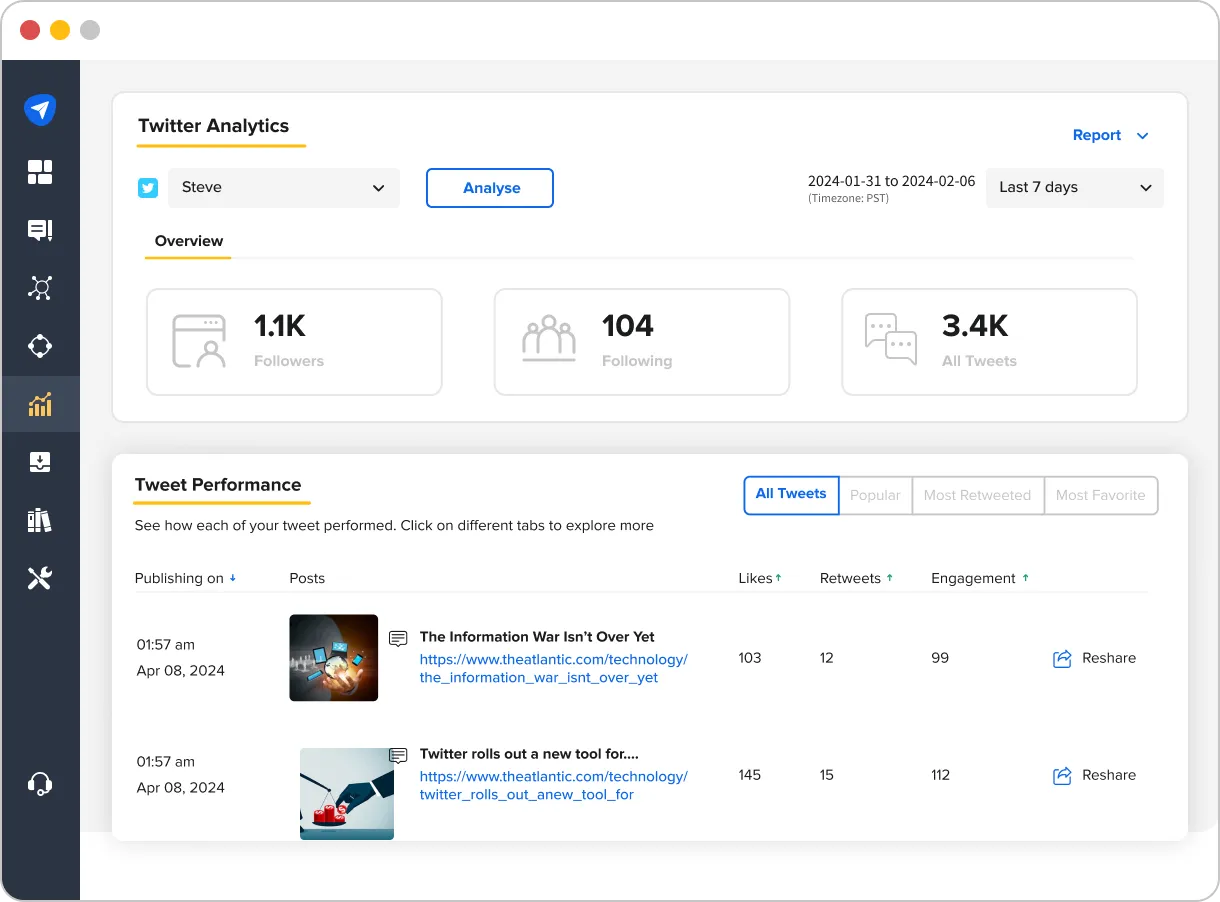You have tried creating content that is actionable, resonates with your target audience and helps drive engagement but you are still struggling to get more likes and retweets on X/Twitter.
If you are wondering why your follower count is not growing, It’s high time you did a Twitter audit.
An audit helps you take a close look at your X/Twitter, what’s working, and what needs to be fixed. You can find out what kind of tweets get you likes and retweets, what kind of people follow you on Twitter, and whether they are even real or just some spammy fake bots.
In this guide, we’ll show you how to perform a Twitter audit and find actionable insights that you can use to improve your Twitter marketing strategy and drive results. We will share tools that you can use to perform your audit and a customizable template that will give you a headstart.
What Is a Twitter Audit?
A Twitter audit is the process of evaluating the performance of your Twitter account to see if it aligns with your social media goals. A well-rounded audit can help you understand what is working in your strategy and what isn’t, as well as how you can optimize your content and profile for increased engagement and growth.
With 66% of businesses already present on the platform and 40% of Twitter users agreeing to purchase products/services they saw, having a Twitter presence is like dropping your weapons in the war. A Twitter audit can help you make better decisions and grow your audience.
What Are the Benefits of a Twitter Audit?
A Twitter audit helps you examine your performance and engagement metrics and understand where your Twitter profile currently stands. Like running social media audits, it can help you find actionable insights that you can utilize to refine your strategy, get more people to engage with your content, and much more.
Here’s what a Twitter audit helps you with:
- It helps you find out how well your profile is optimized and aligns with your business goals.
- What type of content performs best for your account so you can tailor your content for better engagement.
- An audit helps you identify and remove fake followers and spam accounts.
- The insights from the audit help you refine your tweeting strategy and find the best times to post for maximum engagement.
These are just a few of the many benefits of a Twitter audit.
Now, how do you perform it?
How to Do a Twitter Audit: 6-Step Process
Don’t worry—the auditing process does not necessarily need to be complicated. We have broken it down into six simple steps. Let’s get started!
Step 1: Identify Goals and KPIs
Part of the purpose of a Twitter Audit is to see whether your Twitter marketing goals are being met.
Therefore, before you can fulfill this purpose, it might help to take a little trip down memory lane and uncover the goals you intend to achieve with your Twitter account.
What goals do you have for your Twitter business/personal account? Do you want to:
- Increase brand awareness
- Engage with audience
- Drive website traffic to the website
- Increase leads and conversions
- Provide customer support
To clearly define your goals and objectives, you can use the SMART framework (Specific, Measurable, Achievable, Relevant, Time-bound).
Once you’ve set your goals, decide on the Key Performance Indicators (KPIs) that you will use to measure your success. These can include:
- Follower growth
- Engagement rate
- Click-through rates (CTR)
Once you have identified both, it’s time to see whether your current strategies are focused on fulfilling these goals.
Step 2: Audit Your Twitter Profile
Your Twitter profile is the first thing people see when they look your business up on Twitter.
It is your brand’s online representative. Hence, how your profile looks will determine how the audience perceives your brand. Below are the steps for you to follow:
Profile picture and cover photo
The visuals make all the difference. The profile picture enables users to find the brand on Twitter and differentiates your profile from others.
Usually, you would want your brand/business logo to be your profile picture. You can ask yourself these questions:
- Does your profile picture and cover photo look professional and align with your brand?
- Are you using the recent images?
- Are you using the right image sizes for your graphics?
- Do your images use the correct brand colors?
For instance, look how Discord has kept its Twitter profile intact and aligned with the brand:

Tip: Consistently presenting a brand across the internet can lead to a 33% increase in revenue. Therefore, ensure that your Twitter branding is consistent with all other platforms on which your business exists.
Username and handle
Once you have answered all the above questions, your next step would be to look at your username and handle.
- Is your Twitter username recognizable and easy to remember?
- Does your handle match the username, and is it consistent across other social media channels?
If your Twitter handle does not match with other social media profiles? Here is how you can change your Twitter handle.
Check out how Wendy’s has kept their username and Twitter handle the same:

Look at how Wendy’s has a Twitter-verified sign on its profile. For a brand to look authentic and stay apart from fake and spammy accounts, you need to verify your Twitter account.
Twitter bio
Twitter bio is important as well.
This one-line statement summarizes your brand for the audience and is prime real estate.
Capitalize on this space to tell the audience exactly what your brand is.
Remember, Twitter gives you a limited space of 160 characters, so be creative and develop a phrase that captures your brand’s voice and explains your business to the audience. Ask yourself:
- Does your bio provide a clear description of what your business does?
- Does your bio include focus keywords relevant to your business?
- Does it include a CTA?
Hershey’s has beautifully used their bio to convey what the brand does:

Pinned tweets
There is another prime real estate space on your Twitter handle apart from the bio. And that is your pinned tweet section.
Pinned tweets are relatively new and offer an excellent opportunity to push important brand messages to your prospects.
If you use pinned tweets, ensure they are:
Current with the present trends.
Deliver important messages to your audience, like news and updates
Showcase deals and discounts, new product launches, etc.
Check out how the NFL is winning back with their pinned tweet on Tom Brady:

Make sure whatever it is that your pinned tweet promotes ties back to your Twitter marketing goals.
Step 3: Establish Benchmarks
Social media benchmarks refer to the point of reference used to evaluate the performance and effectiveness of a brand’s social media marketing efforts.
A benchmark helps you understand how your current performance compares to your historical performance, industry standards, and competitors. To create a baseline, collect data on your current Twitter performance. Also, look at competitors and industry leaders to set realistic benchmarks.
Ask yourself:
- What has been my average engagement rate over the past 6 months?
- How does my performance compare to that of my main competitors?
- What are the industry standards for a Twitter account of a size and scope similar to mine?
Step 4: Run a Twitter Follower Audit
If you have never had a Twitter audit, chances are your handle has attracted a bunch of meaningless, perhaps even fake followers that don’t add any value to your business.
Who are meaningless and fake Twitter followers?
A meaningless follower could be anyone who doesn’t align with your target audience persona.
The reason you exist on Twitter is to connect with your target audience. But if your followers don’t match the target audience demographics, will your Twitter efforts be worth anything? No.
Similarly, the trend of bot followers is on the rise.
Brands often attract many fake followers that are bot accounts. Social media platforms often crack down on business profiles with an abundance of such accounts.
Therefore, before you celebrate your increase in follower count, perform a Twitter follower audit to weed out fake and meaningless followers.
Examine your followers
Start by digging into your followers’ data. Use native Twitter analytics or a tool like SocialPilot to comprehensively examine your followers’ demographics, age groups, gender splits, and more. Do they represent your target audience?
Growth rate
Understand how your account is growing month-on-month. Again, use Twitter analytics to identify how many impressions you are generating. How many of them are turning into followers? How is your Twitter growth compared to other social media platforms?
Weed out fake followers
You would not want your Twitter profile to be filled with a bot army. Fake followers are a global issue, and brands across the globe face it. You can manually check Twitter fake followers or use a third-party tool like Twitter Audit to streamline this process. See if there are any fake accounts or bots following you, and use this tool to create a fake follower audit report to document everything.
For example, Doritos has nearly 3.7% fake Twitter followers.

Every brand wants to increase Twitter followers, but getting a bunch of fake followers will just ruin the credibility of your account and significantly reduce your engagement rates.
By auditing your Twitter followers, you can identify the most influential ones and make them your brand advocates.
Now, let’s move to our next audit step, also known as content audit.
Step 5: Twitter Content Audit
Content is the centerpiece of your Twitter strategy. When so much is dependent on it, you need to pay the most attention to make it the superhero of the entire script.
A Twitter content audit dives deep into the specifics of what you’re posting on Twitter to figure out what resonates with your audience and when and how you are posting to optimize your strategy.
Start by collecting all your tweets over a period of 3-6 months. This will give you a robust dataset to analyze for patterns and insights.
Here’s how you can conduct a comprehensive Twitter Content Audit:
- Which types of posts generate the most engagement (likes, retweets, replies)?
- Can you spot noticeable trends in engagement related to specific topics or themes?
- How do different hashtags affect the visibility and engagement of my tweets?
- Is there a best time to post of day/week for your account where your engagement levels boost?
- Does your content content align with your target audience’s interests and business goals?
- Which tweets didn’t perform well, and what can be learned from them?
Use Twitter analytics or SocialPilot to identify the top-performing content and break it down into granular levels to spot the patterns, publishing frequency, and more.

You can also get insights into the best-performing hashtags and explore where people have mentioned you on Twitter to interact with them or answer their questions.
Whatever tweet content brings you closer to your Twitter marketing objectives, do more of that.
If infographics drive better engagement, share more of them and hold off on video content if it doesn’t perform well.
A content audit will also uncover the ideal length of your tweets, posting frequency, and the best time to post a tweet.
Step 6: Create a Twitter Audit Report
A Twitter audit can be as comprehensive as you want, with specific areas of focus as well, but one key that remains constant is proper documentation. Maintain an audit report where you add all your findings and share them with your team and clients.
The report not only reflects the current state of your Twitter account but also provides key recommendations based on your findings.
3 Twitter Audit Tools You Need in 2024
An audit requires a detailed breakdown of your Twitter performance, and for that, you need audit tools. These tools assist you in gaining a comprehensive understanding of your Twitter marketing strategy, identifying fake followers, key areas for improvement, and new opportunities that you can tap into.
Here are 3 tools that you must have in your arsenal:
Twitter Audit
We have already demonstrated how this tool helps you find fake followers on your Twitter profile and properly document everything. This tool gives you a holistic view of your following, i.e., how many of them are potential influencers, how many of them are normal followers, and identify less engaging followers.
SocialPilot
This tool is more of a social media management tool that lets you audit your Twitter handle performance. SocialPilot allows you to examine how your content is performing, which posts drive the most engagement, what the best time to post is, how your followers are growing day by day, and a lot more. You can create a report containing answers to all these questions and share it with your team, clients, and stakeholders.
BuzzSumo
BuzzSumo is an open-source content analysis platform that lets you analyze which content performs best for any topic or competitor on Twitter. This allows you to identify high-engagement topics driving views or shares that you might not be using.
Finally, these tools can make your auditing task a lot more easy and streamlined, saving you tons of time and money.
That’s a Wrap
Conducting a comprehensive Twitter audit will help you identify the underlying issues that are restricting the growth of your Twitter profile and discover new opportunities.
By using the above-outlined steps, you can streamline the audit process and propel your business toward growth.
The goal of the audit is to continually refine your approach based on the findings to keep your Twitter strategy aligned with your audience’s needs and your business goals.
Start today, and turn insights into action for a stronger brand presence.
Happy auditing!



